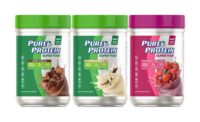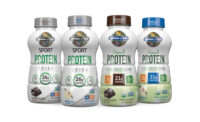PROTEIN-BASED Food Ingredients

The consumption of proteins from foods and beverages is an essential nutritional requirement for humans and animals. Proteins are needed not only to compensate for daily caloric needs, but also to meet the physiological needs for essential amino acids (i.e., the amino acids the human body cannot synthesize and that must be supplied via daily intake). Proteins (or, strictly speaking, amino acids) are so important to the human organism, one of the five basic tastes in human tongues is geared toward recognizing constituents typical of protein-rich foods, underlining the significance food proteins have in human nutrition and in food preferences. This taste, umami, is one of the five tastes perceived via specialized receptor cells on the tongue. Umami is best known as a desirable, non-salty sensation, exemplified by the taste impression of monosodium glutamate.
Proteins as Essential Nutrients
The critical importance of food proteins has been known for a long time. Scientists in the 18th century were curious about how vegetable foods are converted into animal substances. This led to the investigation of commonalities between animal and vegetable substances and, eventually, the discovery of protein. The characteristics of animal substances, such as glue, gelatin and egg whites, have been described for thousands of years. Scientists noted similar physical properties in a glutinous substance, now known as gluten, and animal substances. Animal substances that coagulated upon heating (e.g., egg whites) were defined as early as 1777 by the term albuminous. Fourcroy, in 1789, is credited with first recognizing that albuminous substances in plants and animals were a distinct class of biological molecules--later, they were termed “proteins.”
Proteins are highly valued by humans, and numerous examples show proteins are desired for the texture, nutritional value and flavor they convey to food. Examples include cheese, meat and meat products, fish, chicken, tofu, gluten, hydrolyzed vegetable protein, browning of meat by the Maillard reaction and others. Even from this short list, proteins clearly represent an essential and highly desirable, food constituent for consumers. Many foods are valued according to their protein content (e.g., dairy products, cereal grains, meat, etc.). The value of all these foods increases with elevated protein content.
Not surprisingly, manufacturers pay a premium for raw ingredients that have more protein content. Consumers also are willing to pay more, because they value the texture, flavor and nutritional profile of a product with higher protein content. From early times, these consumer and producer preferences led to the need for a measurement procedure for proteins in food.
Developments in the analysis of albuminous proteins correspond with many developments in analytical chemistry in the 18th century. During this time, the combustion techniques pioneered by Lavoisier were developed to analyze the organic chemical composition of substances, and the idea of using the presence of nitrogen as a marker for proteins began to emerge. From the middle to the late 19th century, a number of important developments improved total nitrogen content analysis techniques for food protein analysis. Many of these remain pivotal to the procedures used today. In 1883, Kjeldahl presented a simple and reliable wet chemistry technique for total nitrogen determination that eventually became the leading measurement procedure for food protein analysis.
Although it is not clear who first reported the use of a total-nitrogen-to-protein conversion factor to quantify the total (crude) protein of food, by 1864, German scientists were using a conversion factor of 6.25 (i.e., the amount of protein is calculated to be 6.25 times the amount of measured nitrogen). However, the use of this factor was based on the false assumptions that all protein consistently contains 16% nitrogen, and all nitrogen in food originates exclusively from protein. In addition, this analysis was based on measurement procedures now considered inaccurate. Leading nutritional science theory of the 19th century also promoted the analysis of total nitrogen in food to measure its nutritional value. The reliance on this approach inhibited the research for alternative markers; limited the development of analytical strategies to separate protein from other food matrix substances before measurement; and promoted measurement based on total nitrogen to calculate total protein content.
Although it is unclear exactly when the practice of establishing the market value of protein-based food ingredients based on total protein content began, the need for reliable procedures to do so dates as far back as the late 19th century. When Kjeldahl presented his new procedure for total nitrogen determination, he justified its use by pointing out that brewers needed a reliable procedure to evaluate the protein contents of barley ingredients.
Reliable Protein Detection
Because the Kjeldahl procedure is still one of those used most prevalently to analyze for proteins, this historic overview serves to highlight the challenges faced today, regarding the analysis of proteins: the use of nitrogen as a marker and a conversion factor that may not be accurate. In today’s world, millions of tons of products valued for their protein content move through the markets, are sourced and traded internationally, and are shipped via complex and convoluted supply chains. Thus, the need for a reliable and internationally recognized protein detection procedure remains as high as ever. The Kjeldahl procedure offers some desirable features: automation, speed, precision, cost-effectiveness and validation for a wide variety of food and beverage matrices. Additionally, the procedure is incorporated in virtually all national and international food laws.
However, the exclusive reliance on organically bound nitrogen as a marker for proteins remains the Kjeldahl procedure’s biggest weakness. In the classic Kjeldahl procedure, nitrogen from any organic nitrogen-containing compound (e.g., melamine) is assumed to originate from protein. This lack of specificity was exploited recently in China, when first cereal isolates and then dairy ingredients were laced with melamine, a substance rich in organically bound nitrogen, to fraudulently make the products appear to be higher in protein content than they actually were. Modifications of the Kjeldahl procedure can enhance its specificity for proteins (e.g., by precipitation of proteins with trichloroacetic acid before analysis), but these steps add other uncertainties, require more time, are more difficult to automate and, thus, are not frequently applied.
The combination of a high-value ingredient and an analytical procedure with low specificity leaves potential vulnerabilities that pose risks to purchasers and consumers. The industry’s response has been multi-pronged, including the development of strong relationships with trusted and ethical suppliers, and the development of alternative procedures. Especially in the dairy sector, alternative procedures have been applied extensively, and milk is tested not only for protein, fat and non-soluble components, but also for its freezing point, fatty acid profiles, triglycerides profiles, etc. These additional tests are applied in an effort to detect potential economically motivated adulteration (in its simplest case, the fraudulent addition of water).
The dairy industry frequently applies infrared spectroscopy as a fast and economic way to test a large number of samples for authenticity. The advantages of these spectroscopic procedures are high sample throughput; on-line and in-line capabilities; and quick and cost-effective analysis. Some of the disadvantages include the need for extensive calibration (these procedures need very large sets of authentic calibration samples) and the need for advanced statistical tools (pattern recognition, multiple non-linear regressions and others) for data evaluation. After being appropriately calibrated, these procedures have the intrinsic capabilities to classify samples according to their similarities to the authentic calibration material and to detect deviations in similarity. This specific feature is a powerful tool in the efforts to detect non-authentic, potentially adulterated samples--without a prior knowledge of the adulterant. In most cases, follow-up analytical work is needed to verify the purity and authenticity of suspect samples, because spectroscopic procedures offer only limited information about the identity of any potential adulterant.
Tailored Methodology Needed
The United States Pharmacopeial Convention (USP) publishes a compendium that sets criteria and analytical methods to authenticate and to determine the purity and quality of food ingredients, called the Food Chemicals Codex (FCC). FCC is a resource that aids in making the food supply chain safer and allows manufacturers and users to distinguish genuine products from inferior and/or adulterated ones. USP held a workshop on “Food Protein Analysis and Adulteration” at its headquarters in Rockville, Md., earlier this year. One of the goals of this workshop was to engage experts from industry, academia and government in a constructive dialog to improve the analytical detection procedures for food protein, in general, and to help prevent the adulteration of protein-based ingredients by other compounds, such as melamine and cyanuric acid (as occurred in a tragic incident that caused the death and injury of thousands of Chinese infants).
During this workshop, it became obvious the current methodology has shortcomings, and, currently, no all-encompassing analytical approach is suitable for the analysis of all food matrices. As noted, the Kjeldahl procedure, with all its benefits, has the intrinsic shortcoming that the global conversion factor from nitrogen to protein is only an approximation for most food matrices. In addition, the lack of specificity for substances other than organically bound nitrogen has proven to be a vulnerability that was exploited in the Chinese dairy scandal, as noted above. The experts in attendance supported the proposal by USP to develop a toolbox for food protein analysis, answering to the analytical needs of various food ingredients in a more tailored way. Encouraged by this support, USP staff and its Expert Committee on Food Ingredients are reviewing the need to update the monographs in the FCC for protein-based food ingredients.
In summary, food proteins are an essential part of human nutrition--humans cannot survive without the intake of proteins. In response to compounds in protein-rich food, the umami taste receptor on the tongue causes a pleasant sensation, which provides additional incentives to humans to consume proteins. The highly valued texture of many foods is caused by, and depends upon, the presence of food proteins, either in their native or denatured form (e.g., cheeses). All of these factors contribute to the high commercial value of food proteins and the need for a reliable way to determine the amount of food protein in order to set a market price.
Because of the ever-increasing complexity of the food supply chain, analytical procedures to determine the amount of food protein (and thus the commercial value of the food) must be commutable and comparable to procedures applied at all points in the supply chain. From a practical and historical perspective, this has boosted the use of the Kjeldahl procedure and, thus, the use of nitrogen as the universal marker for proteins; however, a considerable vulnerability is that it reports all organically bound nitrogen in food as protein. The development of alternative analytical approaches with greater specificity will contribute to increased food safety, by ensuring the authenticity of proteins in food. This will require the cooperation of all stakeholders involved. The FCC staff at USP has proposed the development of a toolbox to address this problem and will work with all stakeholders to further food safety, by minimizing vulnerabilities in the food supply chain caused by insufficiently specific analytical test procedures. NS
Looking for a reprint of this article?
From high-res PDFs to custom plaques, order your copy today!





